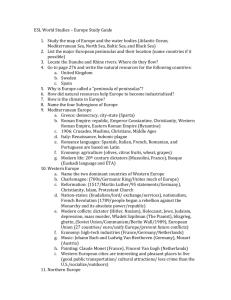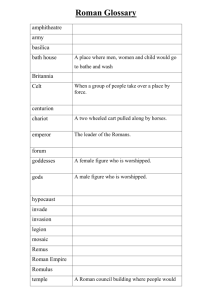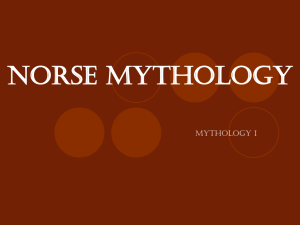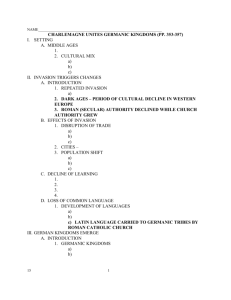Chapter 17 The Germans 300 A.D.—550 A.D.
advertisement
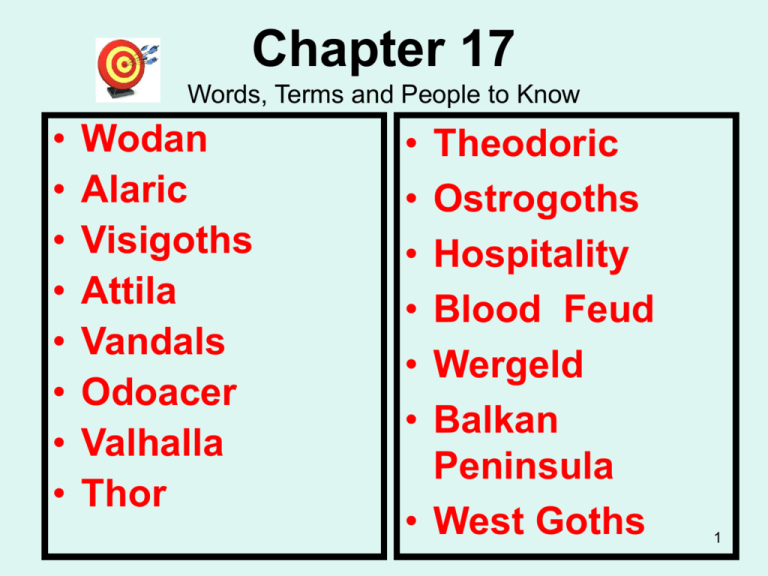
Chapter 17 Words, Terms and People to Know • • • • • • • • Wodan Alaric Visigoths Attila Vandals Odoacer Valhalla Thor • • • • • • Theodoric Ostrogoths Hospitality Blood Feud Wergeld Balkan Peninsula • West Goths 1 The Empire in Crisis: 3c Letts and Lithuanians 1000 B.C. Huns begin to Move into Russia by 370 Celts 1000 B.C. Thanks to the half Goth missionary Wulfila, by the late 3rd cen. many Germanic people were already Christians--heretical Arian Christians. Germans 1000 B.C. In 324 Constantine concluded a treaty with the Visigoths, Made them confederates of the Empire and in return for an annual subsidy they agreed to help defend the empire. Empire in the east remained powerful enough To either defeat the barbarians or rich enough to pay them to move west 2 C-17 Upheaval in the West Huns, Agriculture and Collapse! OH MY! Political chaos in northern China caused the Huns (yellow dots) to move into south Russia by 370. In the following century they continued their migration into what is now known as Hungary, from whence they pillaged under their leader Attila as far west as central Gaul. With the death of Attila in 454, they returned to the Danube basin. Their fierce incursions had forced the Visigoths (purple dots) to cross the Empire’s border and threaten Constantinople. They then passed through Italy and Gaul, ultimately establishing kingdoms in Spain. The Ostrogoths (green dots), under pressure from the Huns, took control of Italy, effectively ending the Roman Empire in the West. 3 Roman court intrigue and the jealousy of rivals helped bring an end to the empire in the West. • Honorius struck a serious blow to his own cause by allowing the assassination of his best general, a man named Stilicho, in 408 CE. So, with the Roman Emperor having done him the favor of eliminating his best defense against them, Alaric and his Visigothic forces invaded Italy with brutal barbarian dispatch and headed for the city of Rome itself. Panicking again, Honorius abandoned the capital, evading the Visigoths by fleeing to another Roman city in Italy, Ravenna, where he watched and waited out their wrath from a safe distance. • Now unprotected, the eternal city, the heart of the Roman Empire, took the full brunt of the Visigoths' rage. In this infamous Visigothic Sack of Rome (410 CE) Alaric and his comrades plundered the city for three days, a devastation which turned out to be actually less physical than psychological but, even so, a wound which went deep into the heart of an already ailing state. When Saint Jerome, the great Latin translator of the Bible, heard the news of the Visigoths' capture of Rome, he wrote "My tongue sticks to the roof of my mouth." The shock was registered in deafening silence empire-wide. 4 • “If the decline of the Roman Empire was WHO TURNED OUT THE LIGHTS?his hastened by the conversion of Constantine, victorious religion broke the violence of the fall, and mollified the ferocious temper of the conquerors.” • Edward Gibbon famously placed the blame on a loss of civic virtue among the Roman citizens. They gradually entrusted the role of defending the Empire to barbarian mercenaries who eventually turned on them. Gibbon considered that Christianity had contributed to this, making the populace less interested in the worldly here-and-now and more willing to wait for the rewards of heaven. • The Decline and Fall of the Roman Empire, Chapter 38 Edward Gibbon The History of the Decline and Fall of the Roman Empire, published in six volumes between 1776 and 1788. 5 Chapter 17 The Germans 300 A.D.—550 A.D. • Feudalism and Transitions 3. Describe the conditions that gave rise to feudalism, (map) as well as political, economic and social characteristics of feudalism, in Asia and Europe. 4. Explain the lasting effects of military conquests during the Middle Ages including: a. Muslim conquests; b. The Crusades; c. The Mongol invasions. The Mausoleum of Theodoric in Ravenna was built in 520 by Theodoric the Great as his future tomb. Its current structure is divided into two decagonal orders, one above the other and both made of Istria stone. It is roofed with a single 300 ton Istria stone of 10 metres in diameter. A niche leads down to a room which was probably a chapel for funeral liturgies. A stair leads to the upper floor. A circular porphyry tub located at the centre of the floor, in which Theodoric was supposed to be buried. His remains were removed during Byzantine rule. 6 Upheaval in the West Weakened by economic, social, and political decline, Rome had turned to the most extreme forms of absolutism in order to survive. Unfortunately for Rome, even this was not enough as increasing pressure from the east in the form of the Huns caused two pulses of migration across Western Europe beginning in 376 and lasting until roughly 380; and then another, beginning in 405 and lasting until 408. It was this mass migration of Germanic people that would ultimately bring about the destruction of an already faltering empire. 7 Increased use of agriculture by formerly forest dwelling populations caused a barbarian population explosion. • The origins of these tribes are shrouded in mystery. They were most likely a people derived from the Celts, but they have much in common with other European cultures. • For the most part, the term "Germanic" is almost entirely a linguistic rather than a cultural term—it refers mainly to the tribal groups in Europe that spoke similar languages. • Germanic languages had most likely been derived from Celtic sources—but, who knows? • Germanic languages probably came into existence around the second century BC—that is, they became distinct from Celtic languages. In both Celtic and Germanic, the word, "German," means something like "the fierce men" or, contrarily, "the friendly men." Once again--who 8 knows? • “Germanic tribes” included the Vandals, Lombards, Alamanni, Goths, Franks, and Burgundians. Most of the tribesmen did not know how to read, but unlike the Huns, they tended to farms and were not Relics are the material remains of a deceased saint or martyr and objects closely associated with those remains. Relics can be of entirethe skeletons, but more gave usually theyup consist of a part such nomadic. Most tribes their For the Germans, a people with written tradition, and no easy access to the as a bone, hair or tooth. Pieces of no clothing worn by the deceased saint or even an deep object that has come in nuances contact with a relic is also considered a relic. haveofplayed an important theological of Roman Christianity, the lives andRelics workings the saints became role pagan beliefs and became Christians. inimportant Christian concrete ritual since the earliest of the church were a major of popular examples theycenturies could understand. Theand veneration of thepart saints th cen. French reliquary religion in an theimportant Middle Ages. Shown becomes part of the religious live of 12 the western church However, most were originally converted to Arianism—a heresy! Of course, these warrior people had a somewhat different view of the faith. 9th century depiction of Christ as a heroic warrior. In the Early Middle Ages the Germans became more Roman Christian and the Church became more 9 barbarous. (Stuttgart Psalter, fol. 23, illustration of Psalm 91:13) After the fall of Rome The “fall” was a real decline in quality of life for people and populations who had been primarily urban dwellers. The church, the primary inheritor of Roman governmental institutions, was primarily urban and in no position to control rural areas. Pagan comes from Latin pagus, countryside Traditional Roman cults persisted until 600 A.D and beyond in rural areas 10 Triggers Change in Western Europe • Disruption of trade—business collapse • European cities destroyed as centers of trade • Money becomes scarce—barter replaces money • Downfall of the cities—cities were abandoned as centers of administration. – Rome in AD 100– over 300,000 eventually reaches 1,000,000 people at its height. – Rome in AD 900 --50,000 people 11 – Lyon France AD 100 --100,000 people – Lyon France AD 900 –15,000 – Trier Germany AD 100 —100,000 people – Trier Germany AD 900 —15,000 • Population Shifts – Nobles retreat to rural areas (often their villas) – Population of Western Europe becomes mostly rural 12 • Loss of common languages Greek and Latin become rare and regional vernacular becomes common = national languages • Concept of government changes – Loyalty to public government and written law had unified Roman society – Replaced by clan loyalties – – Some clans were undoubtedly of mixed culture. They may have assimilated to Germanic. Long-lasting ethnic identities changed population base and language over the centuries. As for genetic characteristics, they must be considered unrelated to clan names. Apart from these limitations, it is probably safe to assume that, on the whole, most of these populations spoke some branch of Germanic and contributed to pools of descendants who currently live in the Germanic-speaking countries. 13 Cornelius Tacitus (ca. 56 – ca. 117) Roman senator and historian wrote of the Germans… • .”For myself I accept the view that the peoples of Germany have never been tainted by intermarriage with other peoples, and stand out as a nation peculiar, pure and unique of its kind. Hence the physical type, if one may generalize… “ 14 The Western and Eastern Roman Empires by 476 15 List of Germanic Tribes in alphabetical order Alamanni Ambrones Ampsivarii Angles Angrivarii Batavii Bavarii Bructeri Burgundians Canninefates Chamavi Chasuarii Chauci Cherusci Chatti Cimbri Dani Dulgubnii Fosi Franks Frisians [edit] Geats Gepidae Goths Harii Helisii Helvetii Heruli Hermunduri Ingvaeones (North Sea Germans) Irminones (Elbe Germans) Istvaeones (Rhine-Weser Germans) Jutes Lemovii Lombards or Langobardes Lugii Manimi Marcomanni Marobudui Mattiaci Naharvali Nemetes Nervii Njars Quadi Rugii Saxons Scirii Semnoni Sitones Suebi Suiones Sugambri Tencteri Teutons Treviri Triboci Tudri Ubii Usipetes Vandals Vangiones 16 The Barbarian Wave 17 : compares the cultures of the Romans and the Germans • Model of type of home used in eastern Europe by Slavic and Germanic people Alemanni houses 18 Most Historians Today Divide the Middle Ages in Western Europe as Follows: • EARLY MIDDLE AGES 500 - 1000 A.D. • CENTRAL (High) MIDDLE AGES 1000 - 1350 A.D. • LATE MIDDLE AGES 1300 - 1500 A.D. 19 I. Village Life – A. villages surrounded by farmlands and pastures – B. long thatched roof huts with one end for the family and the other for the animals – C. basically herders who traded with the Romans, came into the empire looking for grazing lands – D. most farm work done by women, children and slaves – E. German dress • women wore long skirts, scarves or shawls • men wore woolen tunics, close fitting trousers and cloaks fastened with a brooch – F. Germans believed in hospitality; esp. when dealing with strangers – G. Took part in organized sports—boxing, wrestling – H. Spoke language similar to modern German -- could not read or write • gradually learned to speak and write Latin and put their language into that language 20 • I. Warriors • • 1. German men were warriors 2. boys reached manhood after a special gathering held in which he was vested with a spear and shield • 3. Germans divided into clans based on family ties. Their greatest loyalty was to their clan. (Read Tacitus Germania Government. Influence of Women) • • 4. chieftains were elected by a band of warriors—later their title became hereditary 5. little strategy used in fighting, each band fought on its own 6. successful attacks provided warriors with slaves, cattle and other treasures (read Tacitus Germania Arms Military Manoeuvres and Discipline) • • http://www.timelessmyths.com/norse/teutonic.html#Wodan 21 Great Hall of Vahalla Thor’s hammer Mjollnir“— • 7. Germans had many gods and their religion was closely linked to their love of battle. Warriors who died in battle would live and fight and feast forever in a place called Valhalla Comic book Thor pronounced "Mole-near". Odin as Alfdaur (All-father), • • People to Know: Wodan People to Know: Thor – (a. ) Wodan—Chief Germanic god. god of War, poetry, learning and magic • (b. )Thor—Wodan’s son,thunder godgod of thunder Thor - Norse Thor with Mjolnir 22 – 8. Germans admired bravery and expected warriors to win or die fighting –warriors who died in battle went to Valhalla (see next slides) 23 Cosmology Aesir • (from Greek, kosmos, "universe"; and -, logia, "study"), in strict usage, refers to the Elvesstudy of the Universe in its totality as it is now (or at least as it can be observed now), Vanirand by extension, humanity's place in it. Ancient cosmology is sometimes The Norse gods were mortal, and only through Iðunn's could very difficult to reconstruct andapples even they hope to live until Ragnarök. Aesir and Vanir. The Æsir more difficult modern people to maintained their eternalfor youth artificially (through the consumption of Iðunn's golden apples), they could also be slain (for instance, understand. many were preordained to perish at the cataclysmic battle of are the principal gods of the Norse pantheon mysterious creatures associated with thick forests and clear rivers gods of fertility, wisdom, ability to see the future. Ragnarök). (Idun, Iduna) FEW tales remain of this engaging Goddess. She is regarded as the Goddess of Spring and is therefore approximate to Persephone 24 VALHALLA- NORTHERN MYTHOLOGY. • 1. Southward from the world of mist was the world of light. From this flowed a warm wind upon the ice and melted it. The vapours rose in the air and formed clouds, from which sprang Ymir, the Frost giant and his progeny, and the cow Audhumbla, whose milk afforded nourishment and food to the giant. • 2. The cow got nourishment by licking the hoar frost and salt from the ice. While she was one day licking the salt stones there appeared at first the hair of a man, on the second day the whole head, and on the third the entire form endowed with beauty, 25 agility, and power. • 3. This new being was a god. His wife, a daughter of the giant race, would give him three brothers Odin, Vili, and Ve. They slew the giant Ymir, and out of his body formed the earth, of his blood the seas, of his bones the mountains, of his hair the trees, of his skull the heavens, and of his brain clouds, charged with hail and snow. Of Ymir's eyebrows the gods formed Midgard (mid earth), destined to become the abode of man. 26 • 4. Odin then regulated the periods of day and night and the seasons by placing in the heavens the sun and moon, and appointing to them their respective courses. As soon as the sun began to shed its rays upon the earth, it caused the vegetable world to bud and sprout. Shortly after the gods had created the world they walked by the side of the sea, pleased with their new work, but found that it was still incomplete, for it was without human beings. 27 • 5. They therefore took an ash tree and made a man out of it, and they made a woman out of an alder, and called the man Aske and the woman Embla. Odin then gave them life and soul, Vili reason and motion, and Ve bestowed upon them the senses, expressive features, and speech. Midgard was then given them ason the Sö 56 in Södermanland, Sweden. theirrunestone residence, and they became the progenitors of the human race. Midgard (an Anglicized[1] form of Old Norse Miðgarðr), is an old Germanic name for our world, the places inhabited by humans, with the literal meaning "middle enclosure". a:miþkarþi for Old Norse à Miðgarði meaning "in Midgard" - "in Middle Earth", 28 • 6. The mighty ash tree Ygdrasill was supposed to support the whole universe. It sprang from the body of Ymir, and had three immense roots; extending one into Asgard (the dwelling of the gods), the other into Jotunheim (the abode of the giants), and the third to Niffleheim (the regions of darkness and cold). By the side of each of these roots is a spring, from which it is watered. 7. The root that extends into Asgard is carefully tended by the three Norns, goddesses, who are regarded as the dispensers of fate. They are Urdur (the past), Verdandi (the present), Skuld (the future). The Níðhöggr gnaws the roots of Yggdrasill in this illustration spring ata the side is Ymir's well, in which from 17th Jotunheim century Icelandic manuscript. wisdom and wit lie hidden, but that of Niffleheim feeds the adder Nidhogge (darkness), which perpetually gnaws at the root. Four harts (male deer) run across the branches of the tree and bite the buds; they represent the four winds. Under the tree lies Ymir, and when he tries to shake off its weight the earth quakes. 29 • 8. Asgard is the name of the abode of the gods, access to which is only gained by crossing the bridge Bifrost (the rainbow). Asgard consists of golden and silver palaces, the dwellings of the gods, but the most beautiful of these is Valhalla, the residence of Odin. When seated on his throne he overlooks all heaven and earth. Upon his shoulders are the ravens Hugin and Munin, who fly every day over the whole world, and on their return report to him all they have seen and heard. 30 • 9. At his feet lie his two wolves, Geri and Freki, to whom Odin gives all the meat that is set before him, for he himself stands in no need of food. Mead is for him both food and drink. He invented the Runic characters, and it is the business of the Norns to engrave the runes of fate upon a metal shield. From Odin's name, spelt Woden, as it sometimes is, came Wednesday, the name of the fourth day of the week. • • (Odin is frequently called Alfdaur (All-father), but this name is sometimes used in a way that shows that the Scandinavians had an idea of a deity superior to Odin, uncreated and eternal.)31 THE JOYS OF VALHALLA. • 10. Valhalla is the great hall of Odin, wherein he feasts with his chosen heroes, all those who have fallen bravely inconsumes battle, for all who die a peaceful Heiðrún the leaves of Læraðr atop Valhalla death are excluded. The flesh of the boar Schrimnir 18 century is served upIcelandic to them, manuscript.and is abundant for all. For although boar is cooked every morning, Far from being anthis account of gross debauchery, there is mystical be meaning becomes whole again every For drink hidden in every detail of the description of night. Odin's domain and ofthe the feasting abundantly with540 mead theeach of hisheroes warriors.are For supplied example, Valhalla is said to have doors,from through she-goat Heidrum. WhenThis themakes heroes are not feasting of which 800 warriors issue abreast. the number of One-harriers totalthey 432,000, an oft-recurring number in Hindu and Babylonian timethey tables amuse themselves with fighting. Every day dealing with mystic mythic history. Theirand message is in fact one of the ride out intoand the court or field fight until they cut noblest and other most inspiring of mythic tales, between but the lines of each to pieces. This is when theirread pastime; when allegory, fortime here the warriors emerge willingly to betheir "slain" daily in the meal comes they recover from wounds causeand of humanity's evolutionary progress. (?) return to feast in Valhalla. th (or so goes one interpretation) • http://www.sacred-texts.com/cla/bulf/bulf37.htm 32 Cosmology Aesir • (from Greek, kosmos, "universe"; and -, logia, "study"), in strict usage, refers to the Elvesstudy of the Universe in its totality as it is Thor and the Midgard ( Nidhogge ) Serpent (1905) by Emil Doepler now (or at least as it can be observed Ragnarök (Ragnarok) was the doom of the gods and men, and heralded the destruction of the Nine Worlds. To the Germans, Ragnarök was called now), and(Gotterdammerung). by extension, humanity's place VanirGötterdämmerung Nothing will escape the coming destruction, whether youis live sometimes in heaven and on earth. in it. Ancient cosmology The war will be wage between the goods and the evils. The goods were the Aesir, led by Odin, ruler of thewere gods.mortal, The evils,and wereonly the giants and monsters, led by Loki.could The Norse gods through Iðunn's apples very difficult to reconstruct and even Yet the strangest things about Ragnarök was that and the gods already what was they hope to live until Ragnarök. Aesir Vanir. Theknew Æsir going to happen through thefor prophecy: who will be killed and by whom, who would more difficult modern people to maintained their eternal youth artificially (through the consumption survive, what happen to those in the other world and so forth. of Iðunn's golden apples), they could also be slain (for instance, understand. Despite, knowing their fates, the gods will still defiantly face their destiny, as brave as many were preordained to perish at the cataclysmic battle of are the principal gods of the Norse pantheon mysterious creatures associated with thick forests and clear rivers gods of fertility, wisdom, ability to see the future. any hero in a saga. The Norse gods knew what was to come, and knew they could not Ragnarök). (Idun, Iduna) FEW tales remain to of this engaging Goddess. She is regarded as the do anything to prevent prophecy coming pass. Goddess of Spring and is therefore approximate to Persephone 33 J. Law – – – 1. Germans believed the law came from the people 2. based on customs of ancestors 3. passed on in the oral tradition – 4. much law aimed at preventing revenge sought by descendants of people who had quarreled called, blood-feuds – – 5. accused helped by oath-helpers explanation (compurgation) 6. if no oath-helper could be found the accused underwent an ordeal (trial) (lasted until the 13th cen. When it was outlawed by Pope Innocent III and various secular rulers.) • • • • (a.) (b.) (c.) (d.) walk barefoot over red-hot coals arm put into boiling water if burns healed in three days—innocent ordeal by water—if they sink—innocent, float—guilty – 7. courts could impose fined called wergeld • • (a.) sliding scale of fines (b.) legal system did not treat all equally 34 :describes the Germanic invasions and the end of the Roman Empire II. The Conquerors • • • • People to Know: Atilla People to Know: Alaric People to Know: Odoacer People to Know: Theodoric – A. Goths lived in Balkan Peninsula • 1. two subdivisions—Ostrogoths (east) Visigoths migration (west) 35 retired Roman Soldier and historian, Ammianus Marcellinus, writing at the end of the fourth century, described The Huns • “The nation of the Huns . . . surpasses all other Barbarians in wildness of life . . . And though [the Huns] do just bear the likeness of men (of a very ugly pattern), they are… “ • “I say half-raw, because they give it a kind of cooking by placing it between their own thighs and the backs of their horses....” 36 II. Continued – B. In late 300’s both groups (Ostrogoths (east) Visigoths (west) ) Pope Leo I appeals to Attila were attacked by the Huns At Mantua (near Ravenna) to Turn around—he does! led by Atilla the “scourge of God” – C. Huns conquer East Goths Die Hunnen im Kampf mit den Alanen, (The Huns in battle with the Alans), Johann Nepomuk Geiger, 37 1873. – D. West Goths ask for protection of Roman emperor • 1. trouble breaks out between West Goths and Rome • 2. Goths had to pay high food prices and many young West Goths were kidnapped and sold into slavery • 3. West Goths rebel and defeat them at battle of Adrianople in 378 A.D. –(a.) 410 A.D. Alaric captured and loots Rome 39 II. more The deposed emperor was retired to a palace at Misenum in Campania with an annual pension of six thousand solidi. The date of his death is unknown. Though some accounts indicate that he may still have been alive in AD 507-11. – E. West Goths move into Spain, conquer the Romans and another Germanic group called Vandals – F. Vandals cross Mediterranean to North Africa and become pirates known for their acts of destruction. – G. In 455 the Vandals attacked and burned Rome • 1. spared the lived of the Romans – H. Generals in the west fight for control of Rome and Italy – I. 476 German general Odoacer (Flavius Odoacer (Odovacar). kingdom map 40 • "The wretch cannot have had a bone in his body," Theodoric upon cleaving Odoacer (Theodoric had accepted a commission from the emperor in the East to reimpose imperial authority over Italy. In 488 Theodoric, after much fighting-and the treacherous incident mentioned above-- est. a strong Ostrogothic kingdom with its capital at Ravenna. Theodoric maintained classical culture on a high level.) • 1. rules in his own name for 15 years • 2. group of Goths invade Italy and kill Odoacer read and set up their own kingdom under Theodoric – J. By 550 Roman Empire in West was gone • 1. replaced by 6 major and many minor Germanic kingdoms 41 Roman Empire in the East and Barbarian Europe after the Fall of Rome 42 Chapter 17 Essay Question • What are some ways in which our modern civilization reflects ideas and practices of the early Germans? 44
